|
Most Famous Tourist Attractions in Yunnan
Kunming attractions
 |
 |
Dianchi
Lake |
Stone
Forrest |
Stone Forest lies outside of the capital city Kunming, is one of the world's natural wonders. Here, massive pillars of gray rock have formed a gigantic forest of stone. Some of these natural stone formations have the appearance of animals such as snakes, elephants, birds, and dragons.
Dianchi Lake is about 300 square kilometers. It is the largest freshwater lake in Yunnan Province. The lake has a reputation as 'A Pearl on the Plateau'. The lake is crescent-shaped, about 39 kilometers in length and 13 kilometers in the widest part. Its natural banks are formed by mountains on all four sides. More than twenty rivers nurture the lake. The hills contribute to the picturesque landscape, making visitors intoxicated and linger around.
Jinghong attractions
Xishuangbanna Nationality Cultural Park is located on
the bank of the Liusha River near Jinghong city in southern Yunnan Province.
It was built in 1987 and covers an area of 667,000 square meters. The
park is at once a tropical garden and a showcase of regional folkways.
South part of the park has a plant specimen zone, a tropical fruit zone
and a sunbathing and swimming zone. The north section exhibits the traditional
houses and customs of six ethnic minorities - the Dai; Hani; Yao; Jinuo;
Blang and Lahu. They always perform their dances for tourists.
 |
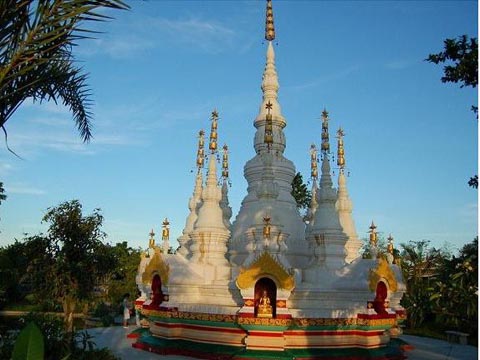 |
Xishuangbanna
Park |
Manfeilong
Pagoda |
The Manfeilong Pagoda
is situated on the top of a hill near Manfeilong Village, 70 kilometers
away from Jinghong City. It was built in the year 1024 and is a famed
stupa complex. It is also known by two other names: White Pagoda and Bamboo
Shoot Pagoda. The pagoda is dedicated to Hinayana Buddhism.
The Manfeilong Pagoda consists of nine stupas. Seen from the distance,
they look very like bamboo shoots that have emerged from the soil after
the spring rain. They are made of bricks, with typical club-like bases
topped by gourd shaped bodies. The principle and central stupa, which
is 16.29 meters high, is surrounded by eight smaller stupas, each being
9.1 meters high. In each stupa, there is a niche wherein a statue of Buddha
is laid. The bells hung at the top of the pagoda make a tinkling sound
when the wind blows. Just to the south of the pagoda, there is a footprint
on the rock. According to legend, this is the left footprint of Sakyamuni,
the founder of Buddhism.
The Manfeilong Pagoda is decorated with beautiful sculpture, relief and
colored paintings in the style of the Dai ethnic minority. During the
Water-splashing Festival (usually on April 13-15), the villagers from
the Manfeilong Village gather at the pagoda and chase one another, splashing
water as part of to welcome the new year in Dai calendar.
Dali Attractions
Mt. Cangshan, is made of 19 peaks. Malong Peak is the
highest. In between every two peaks are streams, and water rushes down
the mountain and pours into Erhai. These streams originate from spring
water or thawing snow and irrigate the farmlands around. Cangshan Mountain
enjoys great reputation for its snow, clouds, springs and marble.
Erhai Lake is the largest highland lake next to Dianchi
and one of the seven biggest fresh water lakes in China. It means, 'sea
shaped like an ear', in Chinese. That Implies that the lake is ear shaped
and as large as a sea. The lake covers an area of 250 square kilometers
and is located about two kilometers east of Dali. It is like a crescent
lying between Cangshan and Dali city as seen from Cangshan Mount. In a
sunny day, the crystal waters of Erhai Lake and the snow mantled Cangshan
Mount reflect with each other. Thus the scene was commonly described as
'Silver Cangshan and Jade Erhai'. The surrounding islands, temples and
villages are worth visiting too. Golden Shuttle Island and the nearby
fishing community of Bai Minority do really deserve a visit with its attractive
Bai culture and lifestyle.
 |
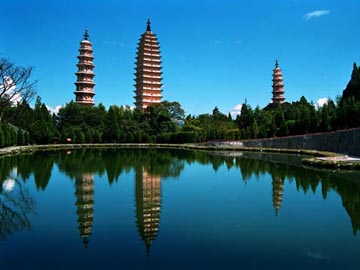 |
Cangshan
Erhai |
Three
Pagodas |
Three pagodas, about
1 kilometer northwest of the ancient city of Dali, occupying a scenic
location at the foot of Mt. Cangshan facing Erhai Lake, has a history
of over 1,800 years. It is a symbol of the history of Dali City, and a
record of the development of Buddhism in the area. As its name implies,
Three Pagodas are made of three ancient independent pagodas forming a
symmetrical triangle. This is unique in China. A visit to The Three Pagodas
should not be missed by any visitor to Dali City. The middle pagoda, Qianxun
Pagoda, 69.13 meters high, is one of the highest pagodas of the Tang Dynasty
(618 - 907), while the other lower two stand to the north and south sides
of it. Many sculptures of Buddha made of gold, silver, wood or crystal,
Buddhist scriptures, were found in Qianxun Pagoda, playing an important
role in explaining the ancient history of Dali City. Three Pagodas has
survived several eras of severe earthquakes. The local government still
makes a great effort to strengthen it to make it as strong as when it
was built to ensure the preservation of this architectural treasure.
The Dali Bai Autonomous Prefecture Museum is near the Erhai Dock. It was
built in 1986. It is really a garden Museum with strong local ethnic minority's
characteristics. It combines ancient Dali architectural styles and Bai
architectural styles. The museum is also the central institution where
the government of Dali Bai Autonomous Prefecture conducts cultural relic
research, excavations, collecting, exhibiting and so on.
Dali Bai Autonomous Prefecture Museum has amassed a considerable
collection. It holds more than 7,000 sub-collections including historical,
ethical, revolutionary and cultural relics, fine marbles and other materials.
Among these are many items found nowhere else in the world but the Dali
Bai Autonomous Prefecture Museum. These include a Dali Bronze Drum, Serial
Bells, etc. from the time of the Warring States (476BC-221BC); the Earthenware
House and the Earthenware Horses from the Western Han (206 BC - 24 AD)
to the Jin Dynasty (265-420); Buddhist Maitreya's Pictures made of different
materials, fine natural marble pictures like 'A Peacock in his Pride'
from the Nanzhao Kingdom and the Dali Kingdom.
Lijiang Attractions
Dragon Snow Mountain lies between 100 04'-100 16'east
longitude and 27 03'-27 40' north latitude. It is the southernmost glacier
in the Northern Hemisphere. Consisting of 13 peaks, among which Shanzidou
is the highest one with an altitude of 5,600 meters, Jade Dragon Snow
Mountain stretches a length of 35 kilometers and a width of 20 kilometers.
Looking from Lijiang Old Town in the south which is 15 kilometers away,
the snow-covered and fog-enlaced mountain resembles a jade dragon lying
in the clouds, hence, the name Jade Dragon Snow Mountain. Jade Dragon
Snow Mountain is a sanctuary for rare animals and wild plants. In fact,
one fourth of all plant species in China can be found here and 20 primeval
forest communities shelter a big family of 400 types of trees and 30 kinds
of animals which are protected by the state. Jade Dragon Snow Mountain
now is a famous scenic spot for sightseeing, mountaineering, skiing, exploration,
scientific research and taking holiday. Besides, widespread legends and
myths of the Naxi ethnic minority and the unclimbed Shanzidou are all
important attractive spots for those who come to Jade Dragon Snow Mountain.
The Old Town of Lijiang, a well-preserved old city of
ethnic minorities with brilliant culture, is a central town of the Lijiang
Autonomous County of the Naxi Ethnic Minority. Located on the plateau
which is 2,400 meters above the sea level and embraced by the tree-covered
Lion Mountain in the west, Elephant and Golden Row Mountains in the north,
vast fertile fields in the southeast and crystal clear water running through,
the old town looks like a big jade ink slab, therefore got the alias the
Town of Big Ink Slab (Dayanzhen).
The Old Town which occupies an area of three point eight square kilometers
was firstly built in the late Song Dynasty and the early Yuan Dynasty
and has a history of more than 800 years. Since Kubla Khan who is the
first emperor of the Yuan Dynasty set his reign here, Lijiang was on a
fast developmental way and became the political, cultural, and educational
center in this area, playing a very important role in the trading activities
among Yunnan, China hinterland, Tibet, India and many other Asian countries.
Till now, when walking on the streets of the Old Town, one can feel the
prosperity and flourish of the town from the shops with fancy and superb
collections of handicrafts.
The Lijiang Old Town is built along the lie of mountains and the flow
of rivers, providing a very precious sample of the research on the old-time
architecture. The unique geographical location, historical background
and multiracial inhabitants make the town the most special one.
The Old Town is the only old city built without a city wall and there
is an interesting story telling the reason. Lijiang had been under the
reign of the hereditary Mu family for more than 500 years. If the Chinese
character 'Mu' (represents the governor of Lijiang) is put into a frame
(represents the city wall), you have the character 'Kun' which means 'siege'
or 'predicament'. This would mean that the governing Mu family and their
descendants would always be trapped like a rat in a hole. Because of this
symbolism, Old Town Lijiang was never given a city wall.
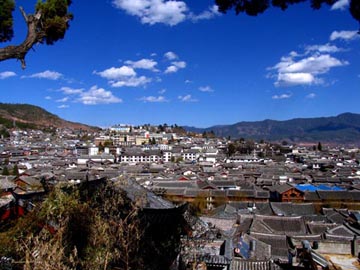 |
 |
The
Old Town of Lijiang |
Jade
Dragon Snow Mountain |
As a result of the combination of the
multinational culture and the progress of Naxi ethnic minority, the buildings
in the town incorporate the best parts of the architectural traits of
Han, Bai, and Tibet into a unique Naxi style. The layout of the town is
free-style and flexible, the houses are close and diverse, and the lanes
are narrow and meandering. Naxi people pay much attention to the decoration,
the commodious and applied houses are mostly timber and tile structure
compound with a garden, each has engraved vivid figures of people and
animals on doors and windows, beautiful flowers and trees in the garden.
Living in such a beautiful and comfortable environment is a real pleasant
thing.
The old Town of Lijiang is a city depends on water for existence and water
is just like its blood. Black Dragon Pool (Heilongtan) is the main water
source of the town and subdivides into many streams which can reach every
family and every street in the town. Due to the reticular aqueducts, willow
trees grow everywhere and there are almost 350 varied and inimitable bridges
in the little town, some of which were built in the Ming and Qing Dynasties.
The usage of the water created by the local people is very scientific.
They build three mouths every well from the upriver to the downriver.
The water in the first mouth is for edibility, the second one is for cleaning
of the vegetables and fruits, and the last one is used to wash the clothes.
The water not only meets the need of the dweller, but also gives the town
a beauty of gentle. The town reputed as the 'Oriental Venice' and 'Suzhou
in Highland', but it is much, much more than this. Once you have visited
Old Town Lijiang, it will capture your heart for the rest of your life.
The center of the Old Town is the Square Street (Sifangjie). Four main
streets radiate from Square Street and extend to the four different directions.
Countless lanes extending in all directions form a network and connect
every corner of the town. Streets in the Old Town are paved by the local
bluestones which are neither muddy in the rainy season nor dusty in the
dry season. The massive and fine-grained stones add a sense of antiquity
and mystery to the Old Town. The sluice at the center of town is opened
late in the night and the resulting current of water flushes and washes
all the streets to keep the town clean. This practical use of water is
part of the daily life of the residents in Old Town.
On December 3rd, 1997, the Old Town of Lijiang was put in the list of
the World's Relics by the World Cultural Heritage Commission of the UNESCO
(United Nations Educational, Scientific, and Cultural Organization). The
charming Old Town is now a famous tourist attraction for its traditional
ethnic culture and customs, inimitable buildings and the wonderful natural
views.
Naxi Murals
Ten kilometers (six miles) northwest of Lijiang Old Town, there are several
ancient villages, including Baisha, Dayan, Shuhe, Yangxi and Xuesong.
There, the invaluable Lijiang Murals are stored, preserved and displayed
in 15 venerable temples, such as Juexian, Wande, Guiyi temples and Sanbi
Garden. Altogether, the mural used to include more than 200 pieces of
fresco. However, hundreds of years of historical vicissitudes have left
only 55 pieces in good condition. The most famous frescos are known as
Baisha Mural of the Dabaoji (Great Treasure) Palace and the Colored Glaze
Temple (Liuli Dian) in the town of Baisha.
Most of the temples were built from the early days of the Ming Dynasty
(1368-1644) to the early Qing Dynasty (1644-1911), and the Lijiang Mural
was created at the same time, over the course of about 300 hundred years.
In Lijiang, it was an era of rapid economic development, mutual acculturation
of multinational culture, and the growth of religions. Accordingly, Lijiang
Mural was an artistic representation of this cooperation, communication
and progress. The authors of these mural paintings had come from different
nations, including the local Naxi Dongba painters; the Taoist painter
Zhang from the Central Plain; Tibetan Lama artist Guchang; Han painters
Ma Xiaoxian and Li Zeng; and many other artists who were unknown to the
public.
 |
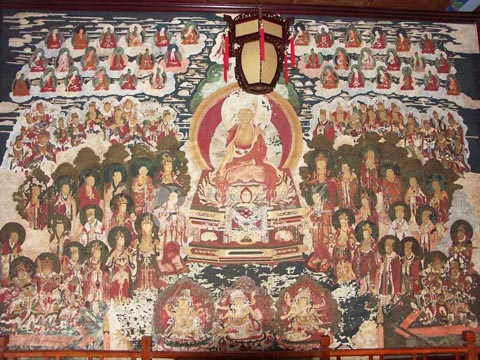 |
Naxi
Ancient Music |
Naxi
Mural |
The originality and figures of the mural
paintings reflect the different religious cultures and artistic forms
of Buddhism, Lamaism, Daoism and the Naxi Dongba religion, as developed
in a Naxi school. Therefore, Lijiang Mural is quite different from other
frescos. Each painting includes at least one hundred portraits, but perspective
is used very well, and the close, middle and establishing images are clear.
The various lifelike portraits are not only Buddhas but also ordinary
people such as bureaucrats, criminals, tourists and executioners. Many
of the scenes and subject matters are drawn from daily life-people are
shown fishing, riding horses, weaving, dancing and casting iron. The painters
used different methods of portrayal within the different elements of the
fresco, such as flesh, garments, jewelry, weapons and many other components.
The style of these true-life frescos is rural and unconstrained; the colors
are strong and have intense contrast but are also unified. The Lijiang
Mural fully demonstrates the superb artistic skills, outstanding creativity
and rich imaginations of these excellent craftsmen. The vivid and exact
figures, flowing lines, well-defined colors and powerful effects of the
exquisite details make the Lijiang Mural not only the rare treasure of
art, but also forceful proof of national solidarity and an important source
of information for research on national religions, arts and history.
Shangri-la Attractions
Shangri-La is a fictional place described in the 1933
novel Lost Horizon by British author James Hilton. In the book, "Shangri-La"
is a mystical, harmonious valley that was surrounded by snow =clad peaks,
blue lakes, broad grassy marshlands, Lamaseries, Buddhist temples, mosques,
Catholic churches. The people of different ethnic groups and the nature
were in perfect harmony. Shangri-La has become synonymous with any earthly
paradise but particularly a mythical Himalayan utopia-a permanently happy
land, isolated from the outside world. The word also evokes the imagery
of exoticism of the Orient. The story of Shangri-La is based on the concept
of Shambhala, a mystical city in Tibetan Buddhist tradition. According
to the research by experts, the area of Diqing Tibetan Autonomous Prefecture
is the original shape of Shangri-La in the novel. In 2002, Zhongdian County
was officially named Shangri-La County by the state council. The scenery
in Shangri-La is really beautiful. It is a Xanadu in the world. Inspired
by the novel, so many tourists from all over the world go there to visit.
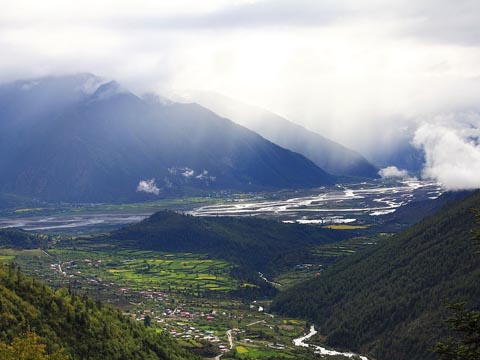 |
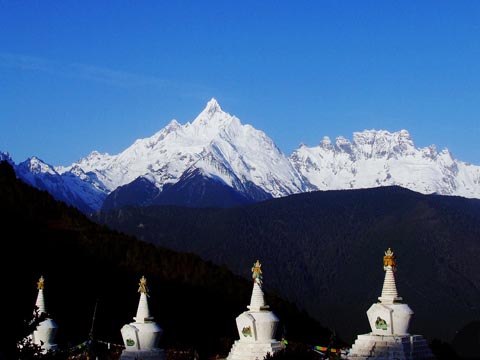 |
Shangri-La |
Meili
Snow Mountain |
Meili Snow Mountain,
also known as Prince Snow Mountain, is located 10 kilometers northeast
of Deqin County. The mountain sits on the border of Yunnan Province and
Tibet where the three famous rivers, namely the Jinshajiang River, Nujinag
River (Mekong) and Lancangjiang River(Salwen) flow.
Meili Snow Mountain boasts numerous snow-clad ridges and peaks, thirteen
of which exceed 6,000 meters above the sea level. The most splendid view
is of the Kawagebo Peak, the highest in Yunnan Province rising about 6,740
meters. It is still a 'virgin peak' for no one has ever reached the top.
Thus, Meili Snow Mountain is a challenge for all mountain explorers from
all over the world.
Owing to its high altitude, the mountain owns several climatic zones with
a diversity of plants, vast expanse of grassland and rich fungi species
that are vertically distributed. The types of vegetation here range from
the Torrid Zone to Frigid Zone vertically. From the altitude of 2,000
meters to 4,000 meters, forests flourish with varieties of spruce. The
depth of the forest is an exotic world of rare birds and animals. The
meadows surrounding the forests are embellished by countless flowers which
add more vitality and charm to the mountain.
Meili Snow Mountain is one of the most sacred mountains of Tibetan Buddhism.
'Kang Karpo Peak' means the God of Snow Mountain in Tibetan, and is a
holy land for worshiping. Pilgrims from Tibet, Qinghai Province, Sichuan
Province, and Gansu Province travel to the mountain at the beginning of
each winter to worship. Thousands of devout pilgrims 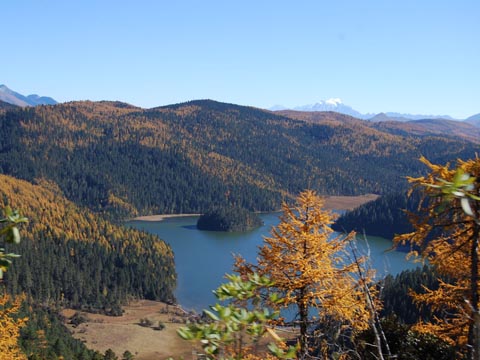 worship
together and encircle the holy mountain, adding even more mystery and
loftiness to the mountain.
worship
together and encircle the holy mountain, adding even more mystery and
loftiness to the mountain.
Bitahai Lake is widely recognized as 'A Pearl on the
Plateau' and the most attractive lake in Shangri-La. Legend has it that
a goddess dropped her mirror carelessly to the earth when she was making
up. The mirror was broken into pieces and they became lakes on the plateau.
Among these pieces, the most beautiful piece with green jade turned into
today's Bitahai Lake.
In the center of the lake stands an islet shaped like a boat sailing in
the lake. The islet is 30 meters above the water level, and is covered
with rare plants and also includes spruces and rhododendrons. Here, birds
twitter happily and flowers emit their pleasant fragrances. When stepping
on the islet, one feels as if they are arriving at Xanadu, and tourists
have frequently remarked about how they have felt intoxicated by the aura,
beauty and tranquility.
Many different rhododendrons add to the beauty of the lake. Every year
around June and July, petals of the rhododendrons fall onto the lake surface
with the wind. When passing fish eat these rhododendron petals they can
be seen on their backs with their white bellies exposed as they float
upside-down amongst the petals as if they are drunk. It is now the best-known
sight of Bitahai Lake. It is also said that in the past bears in the nearby
mountains often came out in the moonlight to catch these intoxicated fish.
Bitahai Lake is a place of legends. When one is here, one can find that
even a tree or a hill around the lake has a story. It is not only a feast
to the eye, but also enhances our sense of beauty and our imagination.
Mobile:(+86-1350 110 3837) Wechat:(13501103837) E-mail: chinasilkrug@msn.com